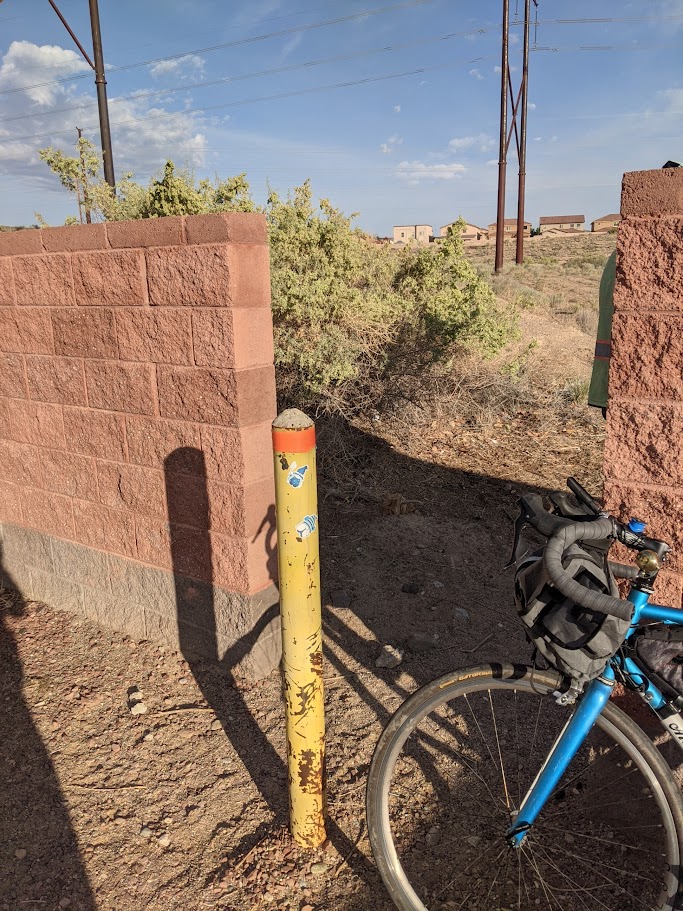In our years of urban exploring of Albuquerque on our bicycles, my collaborator and I have learned a number of guiding principles that I realized might be worth sharing.
The realization came at this gate, which of course I checked to see if it was locked. It wasn’t, which led to the discovery of a marvelous new shortcut. (Marvelous shortcuts, graded first on safety and second on interestingness, are a precious gift. They need not actually be shorter.)
This is a work in progress, but here are a few:
“Dead End” signs are an invitation
“Dead End” and “No Outlet” signs should be viewed as an invitation.
Their placement is generally intended to inform the drivers of automobiles. Not pedestrians and bicycles. I would estimate that roughly half the time I ignore them, I find a way through.
The percentage goes up significantly on Albuquerque’s valley floor, which is spiderwebbed with irrigation and drainage ditches. Consider the delightfully named “Beach Road” in Los Duranes, a neighborhood named after an old village along the Rio Grande. My decision to ignore the “No Outlet” sign was rewarded with a gate designed to allow horses, pedestrians, and cyclists access to the Riverside Drain paralleling the Rio Grande, a delightful dirt path.
Keep an eye out for bollards

A bollard at a gap in a wall with a bicycle in the foreground and a field and houses in the distance, beyond the gap in the wall.
This is a close corollary to the above principle about “No Outlet” signs. Often the cut-throughs at the end of such streets include a space to pass, but with a bollard at the entrance to block motor vehicles. Bollards also guard other gaps in fences and walls.
Consider such bollards an invitation to see what might lie on the other side.
When feasible, take the alley

Irot’s Bird, in the alley behind Central (Route 66) in downtown Albuquerque. November, 2023, photo by John Fleck
Alleys are the most honest part of a city, the back side of things, unadorned. Or, sometimes, spectacularly adorned.
“Graffiti,” Albuquerque city ordinance 11-7-1 explains, “is a form of vandalism which injures and stains Albuquerque.” This is important. In Bogota in 2011, the police killing of a graffiti artist sparked outrage, leading after several years of turmoil to a government decree allowing “responsible and artistic graffiti” in most public spaces. Which triggered deep debates within the community of the artists who made it over the meaning of “true” graffiti.
The deep notion of graffiti as an act of rebellion and place-making is beyond the scope of this blog post, but graffiti has always been at the heart of a “discourse of disorder.” It is place-making, or place-claiming, and it’s delightful, and you’ll find it in alleys. Magnificent work like Irot’s bird, but also ragged tags.
When feasible, take the alley.
Speed Humps
The reason they build speed humps is because cars were driving too fast. Speed humps slow them down.
These signs are thus conveying two important pieces of information.
First, it means the road goes somewhere interesting. That’s why all the cars were going that way and driving too fast, leading to neighborhood meetings and traffic engineering studies and speed hump construction.
Second, it means that what cars still use the street are now likely to be going more slowly.
No Trespassing Signs
Criminal trespass consists of unlawfully entering or remaining upon the lands or property of another knowing that any consent to enter or remain has been denied or withdrawn by the person or persons lawfully in possession of the premises or after the request or demand to leave the premises by the authorized representative of the person or persons lawfully in possession of the premises.
– Albuquerque city ordinances, 12-2-3
My first genuine bicycle exploration, at perhaps age ten, involved an old orange grove barn a few blocks from my house. My friends and I packed lunches and began wandering, finding the barn empty and inviting. We climbed the wooden ladder into the loft to dine.
We were wary of being caught, and nervous about the consequences. It was thrilling.
You should of course always be wary of Albuquerque city ordinance 12-2-3 and its kin. I would never encourage urban explorers to ignore signs such as the one above, or to paint over them or shoot them.
However you respond to signs like the one above, the urban explorer must always respect “No Trespassing” signs on lands of indigenous communities. That’s the only really important rule.





I love THE ALLEYS. One is not a ture Albuquerquean if you don’t know your alleys. I live between 15th and 17th Street and Mountain Road and Central where the neighborhoods are shot through with longgg alleys. Good way to circumvent stop signs and traffic jams on 12th street when there is an accident on I-40 and all the neighborhood streets are clogged with vehicles. Take and alley. Or, when Central is shut down for a 5 K walk or the paved streets are being repaired or a storm sewer is being replaces or a film is being shot and do not enter signs are up. Take the alley.